Best full-frame camera 2022: the top big sensor DSLRs and mirrorless cameras
How to find the best full-frame camera
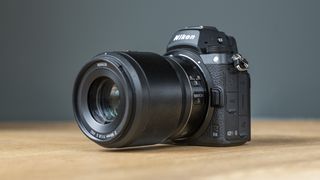
There's so many full-frame models to choose from in 2022, that it can be a bit bewildering to know where to begin. Gone are the days when full-frame was reserved for professionals and/or those with high-end budgets.
That said, you might want to also consider whether you really need a full-frame camera in 2022, particularly if you're keen to save money, and have something lighter and smaller to carry around with you.
A good example of that is Canon's recent R series releases, the R10 and the R7, both of which feature APS-C sensors but offer a wealth of advantages. It pays to consider the merits of full-frame vs APS-C before making any purchasing decisions.
Want to know what the best full-frame camera you can buy is? You’re in luck - you’ll find out here with this buying guide. We’ve got everything here from flagship models, to high-end DSLRs, and everything in between.
To put together this list, we’ve spent hundreds of ours testing all the top full-frame options. Perhaps you’re coming to full-frame for the first time or you’re upgrading from an older model - whatever your needs, we’ll have something in this list right here for you.
Picking the best full-frame camera you can buy right now is a tough task - so much so, we’ve plumped for two, rather than one. We think the Sony A7 IV and the Canon EOS R6 are the best available right now. The Sony is a fantastic ‘hybrid’ camera for both video and photo, with a high-resolution 33MP sensor. The EOS R6 might not offer as much resolution, but it edges it in terms of burst shooting and moving subjects. Those looking for an all-rounder that can deliver in several areas would do well to look at both.
If you’re keen to save some money, there are plenty of cheaper alternatives to think about. If you’re a Nikon fan, the Nikon Z6 II is a great choice, offering decent video and stills specs. One of the only downsides is that its touchscreen only tilts, but that’s unlikely to be a major dealbreaker for most.
It’s also worth considering full-frame DSLRs. They might be a little bit older than mirrorless now, but that usually means you can get some good deals. For example, the Canon EOS 6D Mark II offers reliable image quality, a decent set of features, and crucially for many, excellent value for money.
Perhaps you’ve actually got a very healthy budget. In which case, there’s the hugely powerful Sony A1. This full-frame flagship boasts incredible specifications including a 50.1MP sensor, lightning-quick autofocus and speedy burst shooting. Not forgetting 8K video at 30p too. Both Canon and Nikon have flagship models which offer healthy competition too, with the Canon EOS R3 and the Nikon Z9 both being fantastic choices with anybody with plenty to spend.
We update this guide regularly as new products are reviewed, so you can rest assured that the information is always fresh. In here you’ll find our views on the latest releases, as well as some older models that still offer fantastic value for money in 2022. If you’re not really sure where to begin with choosing a full-frame camera, be sure to scroll to the bottom to find lots of useful tips for finding the best full-frame camera.
- Check out our guide to the world's best cameras for photography
Best full-frame cameras in 2022:
Why you can trust TechRadar
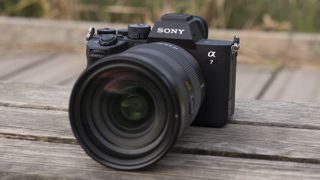
Specifications
Reasons to buy
Reasons to avoid
Sony’s A7 III has long been a full-frame favorite among enthusiasts, so improving on its superb skill set was never going to be easy – but the A7 IV more than delivers. A price increase means it’s not quite the entry-level option that its predecessor was, but there are plenty of improvements to justify the inflation. While a new 33MP sensor doesn’t dramatically improve the quality of still images, it does contribute to a versatile shooting experience that’s better all round.
Powered by a Bionz XR processor, this is a hybrid camera that’s good in almost any situation. Though there’s a crop on 4K footage, Eye AF and 10-bit support also give it proper video chops. Sure, it’s not the easiest camera for beginners to get to grips with. Nor is it the best value for purist stills photographers. But add a huge CFexpress card buffer into the mix and the Sony A7 IV shapes up as a compelling full-frame all-rounder.
- Read our in-depth Sony A7 IV review

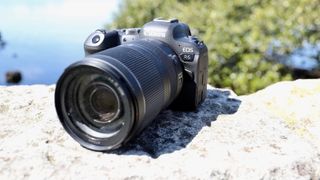
Specifications
Reasons to buy
Reasons to avoid
A more affordable version of the powerhouse EOS R5, Canon’s EOS R6 might well become Canon’s most popular camera – and for good reason. An ergonomic design means the R6 is comfortable for all-day use and, paired with Canon’s outstanding first effort at in-body image stabilization, proves an absolute pleasure to shoot with.
Its video specs can’t rival the R5’s 8K skills, but shooting 4K/60p across the full width of the sensor is hardly shabby. In any case, Canon has made clear the EOS R6 is a stills camera first and foremost. And it’s an excellent one: 12fps mechanical burst speeds jump to 20fps when you switch to the electronic shutter, while the addition of Dual Pixel CMOS autofocus to the 20.1MP sensor results in a significant improvement to autofocus and tracking performance.
The EOS R6's sensor resolution won’t grab headlines and JPEG dynamic range can be a little disappointing, with a lack of detail in highlights and shadows, but overall image quality is still darn good. There’s no question that the EOS R6 represents a massive upgrade from the EOS 6D Mark II – or even the EOS R and EOS RP – though its performance doesn’t come cheap.
- Read our in-depth Canon EOS R6 review


Specifications
Reasons to buy
Reasons to avoid
With a great blend of performance, handling and value, the Nikon Z6 was one of our favorite full-frame mirrorless cameras. The Z6 II takes that very capable base and smooths out a few wrinkles to deliver an even more polished shooting experience.
Unchanged is the 24.5MP CMOS sensor, which continues to capture excellent detail and plenty of dynamic range. The main addition is a second EXPEED 6 image processor, which boosts burst shooting to a maximum of 14fps and improves autofocus performance. Video has also been enhanced, with a firmware update due in February 2021 set to unlock 4K capture at 60p, to compliment the new 10-bit HLG HDR output option.
In the hand, magnesium alloy body parts, weather sealing and a comfy grip make the Z6 II feel more durable than rivals, while a new UHS-II SD card slot resolves one of its predecessor’s key weaknesses. Though the updates might seem relatively modest, the Z6 II is an even more competent all-rounder as a result, making it the most consistent full-frame camera you can buy.
- Read our in-depth Nikon Z6 II review

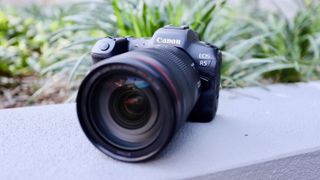
Specifications
Reasons to buy
Reasons to avoid
As its spec sheet confirms, the new Canon EOS R5 is an incredibly powerful tool. In fact, it’s Canon’s best mirrorless camera to date. The 45MP full-frame sensor is exceptional, producing superlative images in low light, with fantastic noise-handling even past ISO 4000.
Next-gen Dual Pixel autofocus, backed up by Canon’s Digic X processor, is similarly excellent, with outstandingly accurate tracking and animal detection skills that will blow away safari shooters. The electronic shutter also delivers rapid 20fps continuous shooting, completing a package that’s as capable on the street as it is in the studio.
Less solid are its hybrid credentials: while it’s hard to ignore 8K footage at up to 30fps – and 4K at up to 120fps – the R5’s versatility for videographers is limited by heat restrictions on recording times, with long ‘cool down’ periods. What’s more, the EOS R5 represents a serious investment, especially if you shell out for the speedy CFexpress cards needed to unlock its ultimate performance. But if money is no object, it’s arguably the top full-frame option for stills photographers.
- Read our in-depth Canon EOS R5 review

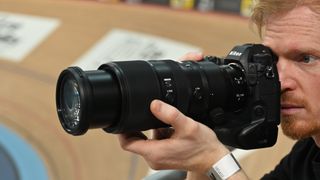
Specifications
Reasons to buy
Reasons to avoid
A big leap forward in technology compared with Nikon’s other Z series cameras, this full-frame powerhouse is superb for professionals and enthusiasts with plenty of cash. Following on from the superlative Nikon D6, this mirrorless equivalent boasts a range of exciting features that should see pretty much every user catered for one in way or another.
There’s a 45.7MP full-frame CMOS sensor and an Expeed 7 processor, both on hand to produce fantastic stills as well as 8K video. It also has an electronic shutter which means it can achieve blistering fast speeds such as 120fps.
During the course of our review, we were particularly impressed with subject recognition and tracking, with fantastic autofocus performance and burst shooting. For sports, wildlife and action shooters, it’s an absolutely dream performance. We also found image and video quality was top-notch too.
In short, pretty much the only thing not to like about the Z9 is its high asking price - but if you want the best of the best, it could be well worth it.
- Read our in-depth Nikon Z9 review

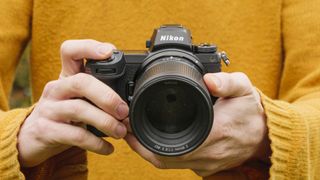
Specifications
Reasons to buy
Reasons to avoid
It might seem like a modest upgrade over the original Z7, but this second-generation of Nikon’s mirrorless model features just enough tweaks to make it a compelling proposition.
Physically it’s very familiar, retaining the excellent form factor and handling of the Z7. Also the same is the 45.7MP full-frame sensor we raved about before, which continues to deliver sharp detail from edge to edge, as well as class-leading dynamic range. One of the key revisions is processing power: twin Expeed 6 chips serve up speedier all-round performance, with improved autofocus, including quick and reliable eye-detection AF.
Deeper buffers mean 10fps burst rates can be sustained for longer, while a pair of SD/CFexpress card slots enhance versatility. Video features have been improved, too, with internal 4K 60fps and Full HD 120fps now possible. Sure, it might not tread much new ground, but aggressive pricing adds to the appeal of the Z7 II, as does a growing catalogue of Z system lenses and accessories. If you’re looking to switch from a Nikon DSLR, it’s well worth considering.
- Read our in-depth Nikon Z7 II review

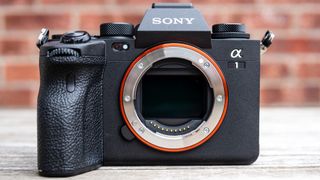
Specifications
Reasons to buy
Reasons to avoid
Remarkable in every respect, the Sony A1 is all the camera you could ever want – provided you’ve got deep pockets. Its 50.1MP full-frame sensor delivers image quality that’s second-to-none, backed up by ultra-rapid autofocus and blistering burst speeds. Besides capturing incredibly detailed high-resolution stills, it can also shoot 8K raw video at 30fps, while pro connectivity options allow for high-speed workflows. Physically, the A1 is a familiar, well-balanced blend of the best bits from Sony’s A7 and A9 series models, complimented by a 9.44-million-dot OLED EVF which more than makes up for the average screen. If you can get to grips with the slightly complex menu system, the A1’s outstanding skills set a new benchmark for mirrorless performance – whether you’re shooting studio portraits, sports action or wildlife footage. There are specialist cameras which offer better value, but for the ultimate in full-frame versatility, the Sony A1 is top of the pile.
- Read our in-depth Sony A1 review

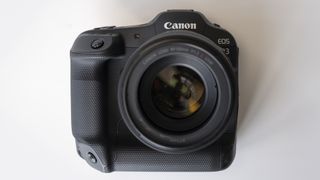
Specifications
Reasons to buy
Reasons to avoid
At first glance, the Canon EOS R3 looks like a chunky DSLR camera from a decade ago. But don’t let its form factor fool you: that old-school body is packed with cutting-edge tech. Chief among the advancements is the 24.1MP full-frame sensor. While its pixel count might sound low, the stacked design equips the R3 with a rapid engine that can deliver 30fps raw burst shooting. It also minimizes rolling shutter when shooting 6K raw video internally at 60p.
Paired with an articulating touchscreen and enhanced autofocus tracking (including Eye Control AF that lets you select focus points by looking through the EVF), the EOS R3 represents a rare combination of talents. In fact, it’s one of the most advanced fast-action cameras ever made – and with a rugged magnesium alloy shell, it’s sturdy enough to survive safaris and sporting events alike. The catch? Its price is as bulky as its body. But while it’s clearly overkill for amateurs, the R3 sets a new standard for professionals who want the ultimate in speed, quality and performance.
- Read our in-depth Canon EOS R3 review

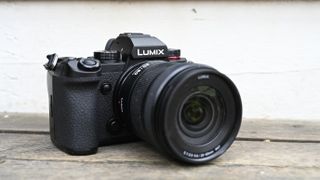
Specifications
Reasons to buy
Reasons to avoid
Combining a full-frame sensor with a compact but ergonomic body, the Lumix S5 shows that Panasonic has learnt lessons from its early full-frame mirrorless models.
At its heart is the same 24.2MP sensor found in the S1, which we already know is capable of producing fantastic imagery. Paired with improved autofocus, a fully articulating touchscreen and the option to shoot uncropped 4K at 30p – plus 10-bit internally – the Lumix S5 makes an excellent travel camera for vloggers and stills photographers alike.
There are, of course, a few compromises as a result of its smaller, lighter body: the 2.36m-dot electronic viewfinder offers less than half the resolution of the S5’s older siblings, while the maximum continuous frame rate is fairly pedestrian at 7fps. Plus some of the larger L Mount lenses significantly increase the size of the whole system.
All the same, the Lumix S5 is an extremely functional full-frame hybrid. It’s comfortable to shoot with and capable of producing excellent results in a range of lighting conditions, yet takes up less satchel space than the GH5.
- Read our in-depth Panasonic Lumix S5 review

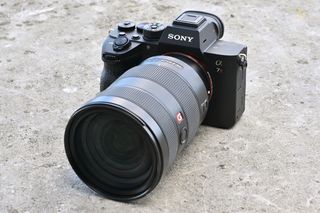
Specifications
Reasons to buy
Reasons to avoid
The A7R IV is the studio-friendly camera in Sony’s full-frame line-up, albeit one that's just as at home shooting action or landscapes. It has an extremely high resolution 61-megapixel sensor, up from 42.4 megapixels in the last version. Such a high pixel count lets the camera retrieve incredible amounts of detail when mounted to a sturdy tripod, in controlled lighting. Noise predictably creeps in more quickly than in a lower-resolution full-frame model, but this is an excellent all-round camera. And while it demands careful shooting for the best results, effective stabilization means it still works well handheld. 4K video quality is great too, aside from some rolling shutter effect.
- Read our in-depth Sony Alpha A7R IV review

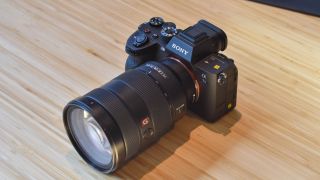
Specifications
Reasons to buy
Reasons to avoid
It was a long time coming, but the Sony A7S III was well worth the wait for video shooters. A complete overhaul of its predecessor, this video-focused full-framer brings a new articulating touchscreen, touch interface, full-sized HDMI port and improved in-body image stabilization. Perhaps most importantly, the combination of a new back-illuminated 12.1MP full-frame sensor and Bionz XR processor delivers hugely impressive image quality, particularly at high ISOs, plus a powerful autofocus system that gives you more granular control than before. Yes, that 12.1MP resolution is a touch on the low side for stills shooters, but the A7S III certainly shouldn't be discounted as a hybrid camera, particularly if you mainly take photos for social media or thumbnails for your video content.
- Read our in-depth Sony A7S III review

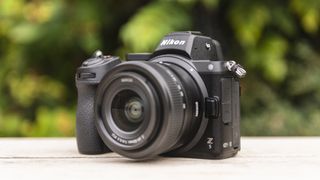
Specifications
Reasons to buy
Reasons to avoid
A dead-ringer for the Nikon Z6 (above), Nikon’s latest large-sensor effort is the best entry-level full-frame mirrorless camera on the market. As a beginner’s option, it ticks a lot of boxes. Its weather-sealed body features a big, comfy grip and a neat control layout that’s accessible in the hand, with a 3-inch tilting touchscreen that makes menu navigation a cinch. The 24.2MP full-frame sensor inside serves up lovely images in a range of shooting scenarios, while the large, bright EVF is fantastic for framing shots. Autofocus is very impressive, too, with the 273-point hybrid system working well for both static and moving subjects. There are some compromises, though: the 4.5fps burst speed is underwhelming, while a 1.7x crop on 4K footage is disappointing. And if you regularly shoot in low-light, the back-illuminated sensor of the Z6 performs better at higher ISOs. Still, the Z5 delivers plenty for those looking for their first full-frame camera – provided you have a healthy budget. It’s pricier than several rivals and, as the cost of the older but more capable Z6 continues to fall, buyers will have a tricky choice to make.
- Read our in-depth Nikon Z5 review

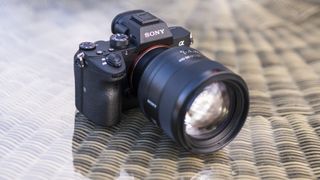
Specifications
Reasons to buy
Reasons to avoid
The A7 III has become a firm favorite among enthusiasts and pros these last few years, and for good reason. In contrast to the more niche A7R IV and A7S II, the A7 III is a camera for everyone, whether they shoot stills or videos, action or static subjects, indoors or out.
The sensor has a modest 24MP resolution, but its backlit design makes for better light gathering, while the advantage of sensor-based stabilization means you don't need to worry about this being in your lenses, which is something many other mirrorless cameras don't have as standard.
Add to that a 710-shot battery life – impressive for a mirrorless camera – a slew of video-specific features and the EyeAF feature for tack-sharp portraits and you have yourself quite some camera, despite its relative old age. The rumors of a Sony A7 IV successor are growing, though, so it might be wise to hold fire for now.
- Read our in-depth Sony Alpha A7 III review

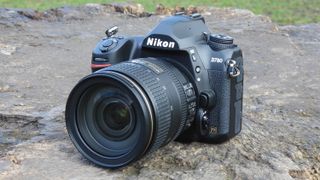
Specifications
Reasons to buy
Reasons to avoid
Don’t believe the naysayers: the DSLR isn’t dead and the Nikon D780 proves it. One of the best full-frame cameras you can buy, it delivers a fantastic shooting experience that should appeal to fans of DSLR handling, while also offering many modern features familiar to mirrorless users. Its sturdy, water-resistant magnesium alloy body might be big and heavy, but the trade-off is a satisfyingly chunky grip. Image quality from the D780’s full-from 24.5MP sensor is truly fantastic, too, aided by Nikon’s EXPEED 6 image processor. Exposures are nicely balanced, courtesy of a metering and scene recognition system borrowed from the D850, while the 273-point on-chip phase detection system – as used by the mirrorless Z6 – ensures fast and reliable autofocus performance when using Live View on the tilting touchscreen. The lack of in-body image stabilization is a shame, but superlative battery life rounds out what is a superb – if pricey – full-frame all-rounder.
- Read our in-depth Nikon D780 review

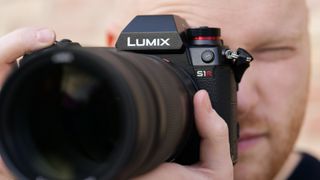
Specifications
Reasons to buy
Reasons to avoid
The S1R offers some very impressive tech in a supremely rugged body. The 5.7million-dot viewfinder is, without question, the most impressive on the market right now, while stellar video quality, great image stabilisation and a huge buffer all put a big smile on our face too. At the time of its release, the 47.3MP sensor had the highest number of pixels on any full-frame mirrorless camera too, although it's now been beaten by the Sony A7R IV. Its main party trick, however, is the ability to output 187MP images; quite how often you'll need to print your images to the size of a small country is another matter, but this clearly gives you massive scope for extreme cropping, enlargements to all sizes and homing in on the smaller details in the scene. We have some reservations with the autofocus system, and it's a little on the beefy side too, but for its combination of build, features and overall execution, the S1R scores many points.
- Read our in-depth Panasonic S1R review

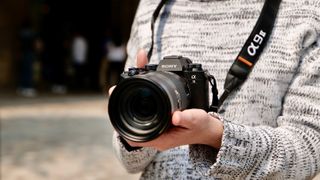
Specifications
Reasons to buy
Reasons to avoid
The main mirrorless rival to the incoming Canon 1DX Mark III and Nikon D6 for pro sports photographers, the Sony A9 II builds on the considerable foundation laid by its predecessor, adding dozens of improvements that collectively make it a one of the best cameras we've tested. The main improvements are its deeper grip and boosted 10fps burst shooting with the mechanical shutter. These are added to the refined 693-point AF system, which now offers even better subject tracking than the original Sony A9 and is perfect for sports and wildlife. It's not cheap, of course, but if you're an action fan, you won't find a better mirrorless camera than this.
- Read our in-depth Sony Alpha A9 II review

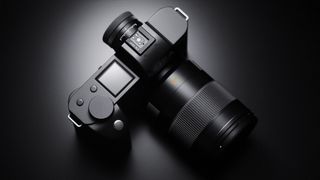
Specifications
Reasons to buy
Reasons to avoid
Leica’s most mainstream mirrorless camera to date, the SL2 still offers a look and feel like no other full-frame mirrorless camera.
It’s a weighty beast, but a redesigned handgrip and control panel layout promise excellent ergonomics, complimented by a minimalist array of unmarked, fully customizable buttons and a refreshed user interface. It handles comfortably and feels wonderfully premium, with a distinctive shell milled from durable aluminum and magnesium alloy.
There’s been an even greater overhaul on the inside: the Leica SL2 gets a new 47MP sensor, a new Maestro III processor, a new 225-point autofocus system and a new EVF. It all makes for a package that’s as fast and accurate as any of its Japanese rivals, delivering crisp images, plenty of dynamic range and excellent color reproduction.
Add sensor-shift in-body image stabilization into the mix, together with 5K footage at 30p and full-width 4K DCI and UHD at 50p, and the SL2 shapes up as an impressively versatile tool. The price reflects both the camera’s quality and that undeniable Leica experience – but the SL2 is also refreshingly accessible, and delivers some pretty special results.
- Read our in-depth Leica SL2 review

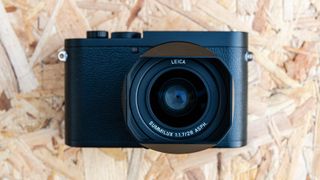
Specifications
Reasons to buy
Reasons to avoid
For most people, the Leica Q2 Monochrom makes no sense. It only shoots in black and white, yet costs more than its very capable and full-color Q2 cousin – which means it’s extremely expensive. But in the slim niche that it occupies, the Q2 Monochrom is also an outstanding camera.
If you’ve long lusted after Leica machinery, it represents a more affordable option than an M10 or M10 Monochrom. Despite its compact shell, the Q2 Monochrom is heavy in the hand, with a solid build that oozes class. Its matte black body and minimalist control interface are Leica hallmarks, yet an intuitive menu system, together with ‘modern’ features such as autofocus and Wi-Fi, make shooting and sharing simpler. The Q2 Monochom’s unique combination of a 47.3MP full-frame sensor with a fixed focal length Leica Summilux 28mm f/1.7 lens produces exceptional results.
With no color array and no interpolation algorithm, still images have an outstanding purity. There’s significantly less noise than standard cameras, so it’s safe to shoot at the maximum ISO of 6400 in everyday scenarios, making the Q2 Monochrom perfectly suited to street photography. The ‘standard’ Q2 is more mainstream, but if black and white is your bag, the Q2 Monochrom certainly makes a statement.
- Read our in-depth Leica Q2 Monochrom review
Also consider...
Looking for something a bit cheaper? Here's a great value full-frame option:
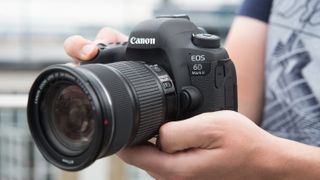
Specifications
Reasons to buy
Reasons to avoid
When the original EOS 6D launched, it offered the best bang for your buck and that trend continues with the second generation DSLR – the EOS 6D Mark II still offers an an excellent entry into the full-frame market. Released in 2017, it has a significant bump in features over it's predecessor, including a higher sensor resolution at 26.2MP, a better autofocus system with 45 cross-type AF points, 6.5fps burst speed and introduces touchscreen functionality to the 6D line. Performance in the real world is smooth and you won't find much to complain about in terms of image quality. And you get all that for around $1,500 / £1,349 / AU$1,999, which is very good value for money.
- Read our in-depth Canon EOS 6D Mark II review

Not sure whether to buy a DSLR or mirrorless camera? Check out our guide video below.

How to choose the best full-frame camera for you
There are several things to look for when choosing the right full-frame camera for your needs and budget. Every full-frame camera will feature a larger sensor than an APS-C or Micro Four Thirds model, meaning you should benefit from improved image quality and enhanced low-light performance. But there are a few key specs to look at in addition.
While sensor resolution is an important consideration, it’s not always an indicator of outright image quality. The Sony A1, for example, features a 50.1MP resolution for capturing stunning stills. In contrast, our favorite full-frame camera right now – the Canon EOS R6 – only features a 20.1MP resolution, but that lower pixel count means bigger pixels, which can translate into better light sensitivity for shooting in dim scenes.
Another key factor to keep in mind is the physical dimensions of a full-frame camera. Due to the size of the sensor, full-frame cameras are inevitably larger than most mirrorless and premium compact models. That said, some are bulkier than others. The Nikon D780, for example, is big and heavy, but the trade-off is a chunky, comfortable grip. On the flip side, the Panasonic Lumix S5 manages to squeeze a full-frame sensor into a Micro Four Thirds-style body that’s small yet ergonomic – and more convenient to carry.
As for other considerations, these are the same as for any other camera purchase and will depend primarily on your style of shooting. Whether you need a tilting touchscreen or a fully articulating screen, for example, will come down to how you like to frame your shots. Equally, the relevance of 4K (or even 8K) video resolution will be determined by your desire to shoot footage with your full-frame camera. It’s a similar story for connectivity and live-streaming features.
Of course, budget will often be the most important factor, but value isn’t always easy to determine. While entry-level models are usually cheaper, a more advanced but accessible camera is likely to go further with you on your photographic journey. Equally, slightly older models may not offer the most cutting-edge specs, but many continue to represent excellent value. It’s also a good idea to keep lens availability in mind: a full-frame camera with support for a wide range of compatible lenses will offer greater creative flexibility.
Are full-frame cameras better?
There are many reasons why you might want to buy a full-frame camera. As the name suggests, the primary advantage is sensor size. Full-frame sensors are substantially larger than those found in APS-C, Micro Four Thirds and compact cameras.
That extra sensor size can be used in a few ways. Some full-frame cameras fill their sensor with more pixels, to record stills at higher resolutions. The Canon EOS R5 shoots images at a 45MP resolution, for example, while the Sony A1 captures snaps at 50.1MP.
Alternatively, a full-frame sensor with a lower resolution can benefit from bigger pixels, which can capture more light in a particular scene and enhance low-light performance.
Either way, full-frame cameras will generally be able to shoot higher quality images in a given scene, particularly in more challenging lighting. The trade-off is often body size, which needs to be larger to make space for the larger sensor. There are a few more compact full-frame camera options, such as the Panasonic Lumix S5, but travelers might find that a mirrorless model or premium compact is more suited to their needs.
Whether full-frame cameras are better in other ways will depend on what and how you like to shoot. A larger sensor doesn’t necessarily mean that a full-frame camera will shoot at higher burst speeds than a APS-C mirrorless model, for example, or that it will have faster autofocus. That’s why it’s important to consider all of a camera’s specs and features when selecting one that’s right for you, not just its sensor size.

How we test full-frame cameras
Buying a full-frame camera these days is a big investment, so every camera in this guide has been tested extensively by us. These days, real-world tests are the most revealing way to understand a camera's performance and character, so we focus heavily on those, along with standardized tests for factors like ISO performance.
To start with, we look at the camera's design, handling and controls to get a sense of what kind of photographer it's aimed at and who would most enjoy shooting with it. When we take it out on a shoot, we'll use it both handheld and on a tripod to get a sense of where its strengths lie, and test its startup speed.
When it comes to performance, we use a formatted SD card and shoot in both raw and JPEG (if available). For burst shooting tests, we dial in our regular test settings (1/250 sec, ISO 200, continuous AF) and shoot a series of frames in front of a stopwatch to see if it lives up to its claimed speeds. We'll also look at how quickly the buffers clears and repeat the test for both raw and JPEG files.
In various lighting conditions, we also test the camera's different autofocus modes (including Face and Eye AF) in single point, area and continuous modes. We also shoot a range of photos of different styles (portrait, landscape, low light, macro/close-up) in raw and JPEG to get a sense of metering and its sensor's ability to handle noise and resolve fine detail.
If the camera's raw files are supported by Adobe Camera Raw, we'll also process some test images to see how we can push areas like shadow recovery. And we'll also test its ISO performance across the whole range to get a sense of the levels we'd be happy to push the camera to.
Battery life is tested in a real-world fashion, as we use the camera over the course of the day with the screen set to the default settings. Once the battery has reached zero, we'll then count the number of shots to see how it compares to the camera's CIPA rating. Finally, we test the camera's video skills by shooting some test footage at different frame-rates and resolutions, along with its companion app.
We then take everything we've learned about the camera and factor in its price to get a sense of the value-for-money it offers, before reaching our final verdict.
- Best camera
- Best entry-level DSLR
- Best DSLR
- Best mirrorless camera
- Best 4K camera
- Best compact camera
- What camera should I buy?
- Mirrorless vs DSLR: 10 key differences
- Camera rumors


Get daily insight, inspiration and deals in your inbox
Get the hottest deals available in your inbox plus news, reviews, opinion, analysis and more from the TechRadar team.

Mark is TechRadar's Senior news editor. Having worked in tech journalism for a ludicrous 17 years, Mark is now attempting to break the world record for the number of camera bags hoarded by one person. He was previously Cameras Editor at both TechRadar and Trusted Reviews, Acting editor on Stuff.tv, as well as Features editor and Reviews editor on Stuff magazine. As a freelancer, he's contributed to titles including The Sunday Times, FourFourTwo and Arena. And in a former life, he also won The Daily Telegraph's Young Sportswriter of the Year. But that was before he discovered the strange joys of getting up at 4am for a photo shoot in London's Square Mile.
